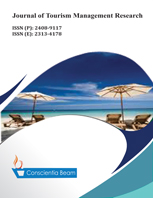Determinants of Resilience Building in Tourism: A Case Study on Romania in the Context of the Pandemic Crises
DOI:
https://doi.org/10.18488/31.v10i1.3237Abstract
This article investigates the evolution of Romanian tourism to identify the regions most resilient to health crises (swine flu and COVID-19) and to show the differences in regions’ responses to these types of shocks. The crises seriously affected the tourism sector globally and in Romania. Furthermore, due to tourists' fears of contracting an illness during travel, the value of the relevant indicators registered a significant decrease, also impacting the connected sectors. A resilience efficiency index was computed and used in the analysis. The index was a ratio between the output under shock and the normal output. A vector error correction model was developed to emphasize the short-term and long-term relationships between regional development and tourism performance during 1993–2020. The index values computed for 2020 and the evolution of the tourism demand showed that the Romanian regions were not resilient. On the supply side, some regions were resilient during the swine flu pandemic, and some were resilient during both pandemics. The regions displayed different responses to shocks, proving that along with the potential of the tourism sector, other factors are also important, such as management and public policies.

